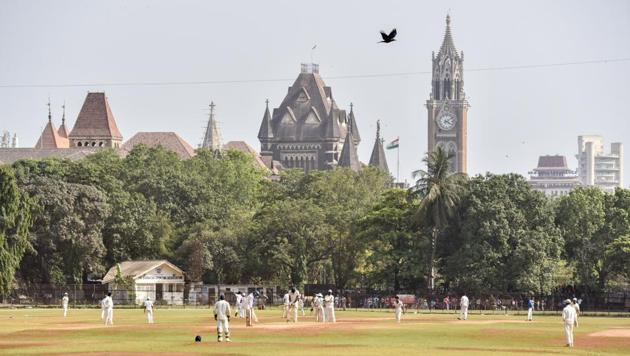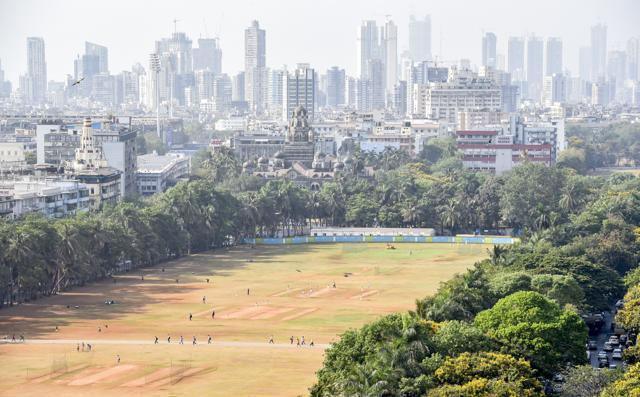Fields of dreams: How Mumbai’s sprawling maidans brought people together
From being evening recreational zones to becoming the mecca of cricket, the city’s biggest open spaces has something for everyone
It’s high noon in the city’s bustling borough called Fort. The unrelenting sun is not doing anyone any favours, least of all the budding cricketers, kicking up a mini-dust storm in the middle of the city’s iconic Azad Maidan. But they are powering through, with no signs of a single furrow on their face. These kids have made their way here from the outskirts of Mumbai, and they are not about to let go of an opportunity of playing their favourite sport on a ground where Sachin Tendulkar and Vinod Kambli created their 664-run record-breaking partnership way back in 1987. It is because of records like this that Mumbai’s biggest open spaces — Azad Maidan, Oval Maidan, Cross Maidan and Shivaji Park — will always remain special to a city increasingly struggling for space.

A brief history
The largest maidans of south Mumbai, namely Azad, Oval and Cross, were once a part of a single stretch of open space called the Esplanade in the mid-1800s, “stretching from Lohar Chawl (present day Crawford Market) to beyond Cooperage,” according to the late historian Sharada Dwivedi’s book Bombay: The cities within.
More of an evening recreational zone for the city than the sporty atmosphere it is known for today, the city’s inhabitants would descend onto the Esplanade for a round of cards or chess. There was a military ban on construction on the patch. “This stretch would see parades and was a very important space in the city,” says Mumbai-based conservation architect Abha Narain Lambah. But after the fort walls that enclosed the city were brought down, the Esplanade become prime property, resulting in some of the most majestic public buildings that have stood the test of time. The open spaces, too, were divided into four distinct sections: in the north, Cross and Azad maidans, Oval at the centre and Cooperage in the south.
Shivaji Park is a relatively newer maidan, built by the Bombay Municipal Corporation in 1925. Besides its deep cricketing roots, this maidan was the venue for several protests in the pre-Independence era and was also the epicentre of the Samyukta Maharashtra movement.

Mecca of cricket
“Mumbai was for a while the biggest centre for cricket,” says eminent sports analyst and commentator Ayaz Memon. “These maidans are open to the public unlike the expensive private clubs. They have produced some of the best batsmen, not too many bowlers, because of the tough conditions and hard pitches. You have to keep your eye on the ball. Also, these kids come from far and wide early in the morning. So they learn how to preserve their wicket early on, otherwise they have made such a long journey only to get out early and sit around,” Memon says.
For former India player Vinod Kambli, Shivaji Park is a place of great nostalgia. “It was a second home to me,” he says. “The feeling I got every time I entered that ground is indescribable. This is where Achrekar sir [his coach Ramakant Achrekar] taught me the basics like how to water the ground and prepare the wicket.” Kambli says there was no place to play cricket in the Kanjurmarg chawl he grew up in. “A bunch of us would often bunk school to watch our favourites play at these maidans and we dreamt of joining them one day,” he says. And indeed, a few years later, he did.
Another legendary cricketer from Mumbai, who also went on to play for India, Ajit Wadekar, was born and brought up in Shivaji Park. According to him, Mumbai’s maidans toughen up a cricketer. “The outfield at Shivaji Park was terrible. If you were fielding near the boundary, diving for the ball meant getting seriously hurt. Luckily, I was always fielding in the slips so I escaped,” he says with a guffaw.
While weekdays are slow, the grounds are filled to the brim on weekends. Wadekar recalls how at one time, at least six-seven matches were being played and there was much confusion about who is playing in what team. “Also, the boundaries at Cross Maidan and Azad Maidan were short. So if you hit the ball across the wall then a batsman could easily make 6-8 runs until the ball was eventually found.”
In and around the maidans
These grounds are more than just about the cricket. For Shivaji Park resident Sonam Sule, 29, it is where she catches up with friends and works on her fitness. “It’s a huge open space that is stone’s throw away from my house. And it is teeming with activity. You will see people jogging, cycling or playing tennis. It is so much better than the cramped public gardens around the city. I also bring my grandmother here for the fresh air and some exercise. There is something to do here for people of all ages.”
Kambli warmly remembers the Khau Galli (food lane) near Cross Maidan. “We would never carry lunch. That Khau Galli would keep us motivated. During our lunch break, we would eat pav bhaaji and vada pavs to our heart’s content at the various stalls there. We never once felt the need to go to a restaurant to eat,” Kambli says.
The area around the Oval Maidan is also a treasure trove. “Nowhere else do you have an open space that is flanked by Victorian Gothic architecture on one side and art deco buildings on the other. They are styles from two different centuries,” says Lambah.

Of the people, for the people
Mumbai’s maidans have not just galvanised budding cricketers, they have brought the city together to fight for several causes. In fact, there is a protest happening at Azad Maidan as you read this. Parents from the city’s schools began an indefinite hunger strike on the maidan on Thursday at noon to protest the government’s failure to act against exorbitant fee hikes.
The Mumbai police are also considering setting aside a space for public speaking and protests — a 10,000sqm area on the west flank of Azad Maidan — so people can protest in an organised manner without disturbing traffic on the arterial roads.
The fight to get the Oval Maidan precinct a heritage tag also saw several residents come together. Lambah, who prepared the heritage dossier for submission to the United Nations Educational, Scientific and Cultural Organization (UNESCO), with the help of several citizens’ groups, says, “This is the only case where the fight was not funded by the government, but by residents.” Lambah said several citizens’ associations from Churchgate, Nariman Point, Oval and Cooperage areas raised funds so that foreign experts could survey the area for the dossier. “There is a great sense of pride among these residents,” Lambah says.
The ground itself was in a pitiable condition for years. It was in 1997 that the state government finally allowed the Oval Cooperage Residents Association (OCRA) to take over its maintenance. The association formed the OVAL Trust, which gave the ground a complete makeover in 1999 at a cost of Rs1.3 crore. The trust famously had to remove 350 truckloads of garbage and debris to clear out the area.
Meanwhile, back at Azad Maidan, it is lunch time and the tired and hungry players have left the field. The dust on this ground has now settled down, but the hopes and dreams it has ignited continue blowing in the wind.
Stay updated with all the Breaking News and Latest News from Mumbai. Click here for comprehensive coverage of top Cities including Bengaluru, Delhi, Hyderabad, and more across India along with Stay informed on the latest happenings in World News.
Stay updated with all the Breaking News and Latest News from Mumbai. Click here for comprehensive coverage of top Cities including Bengaluru, Delhi, Hyderabad, and more across India along with Stay informed on the latest happenings in World News.





